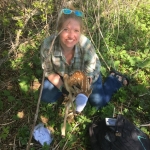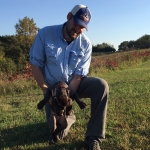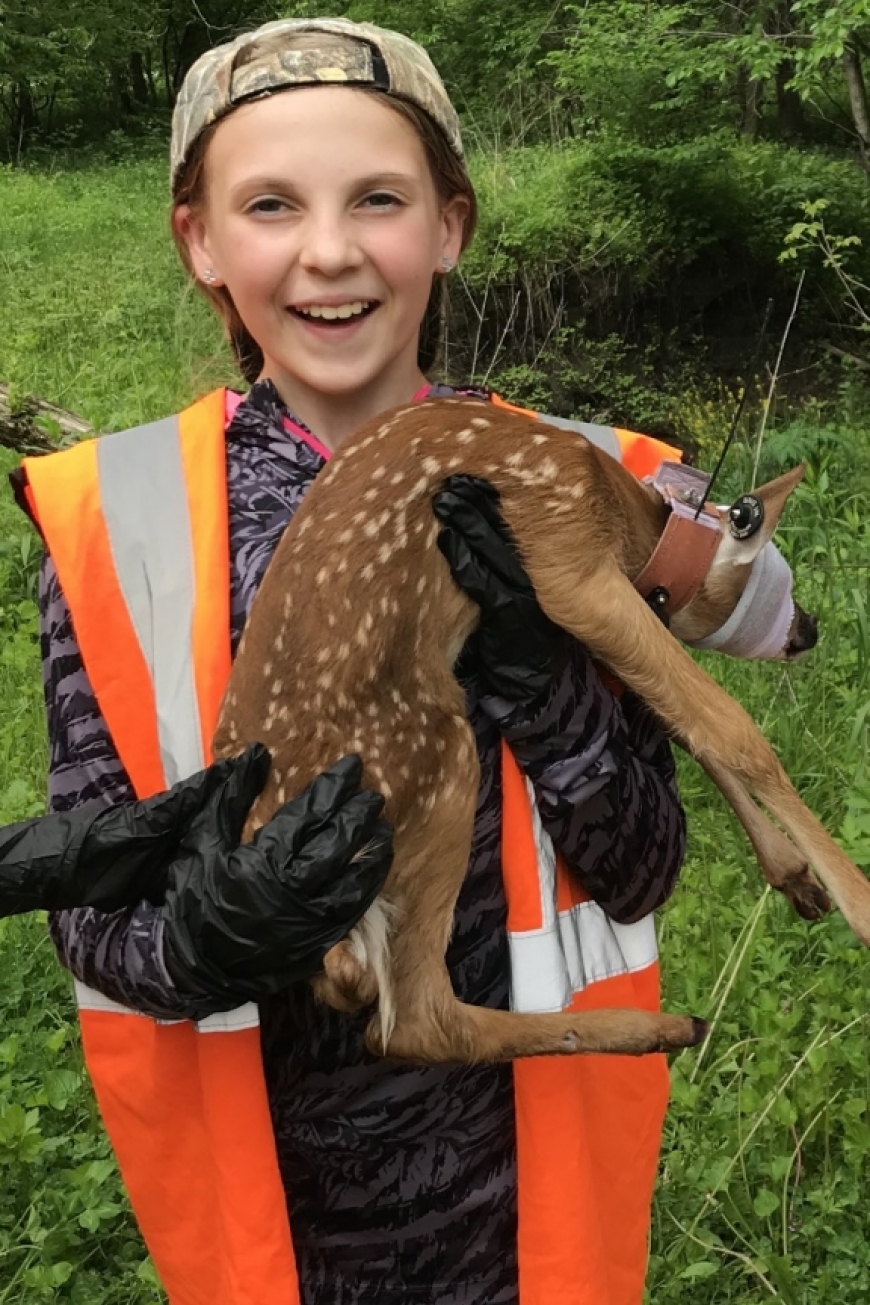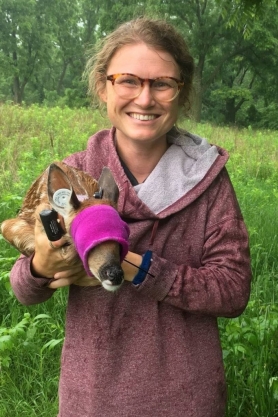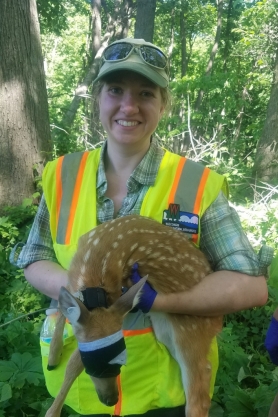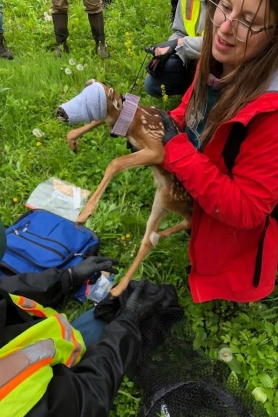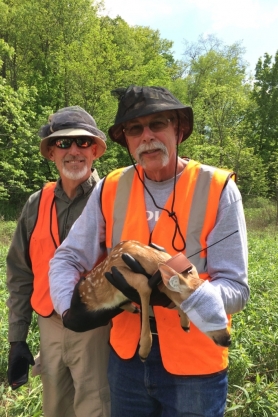Field Notes Newsletter November 2020
The most recent edition of the newsletter covered the Southwest Wisconsin CWD Deer and Predator Study heading into its second phase. We recapped the project from a research perspective, but we want to spend some time recognizing the different groups of people who helped make phase one successful: The landowners, volunteers, staff and other members of the public who have followed our success over the years.
This edition is for and about you. Read about a defining experience of one middle school student, catch up with former field crew leads, see more photos of volunteers holding fawns, and read a thank you note from the project's head researcher. Click the titles below to read this issue’s full articles and view our videos.
A Teacher, A Field Trip, and One Student’s Special Take-Away
Students get excited for field trips because it is an opportunity to get out of the classroom. However, one specific field trip to capture fawns helped a young student envision a new future for herself. Brilie Esser, the student, and her teacher, Kirby Kohler, shared their story with us.
Where Are They Now? Checking In With Past Crew Leads
We caught up with three of our former staff members that many of you will recognize. They shared how their time and experience with the project impacted their lives, as well as what they are up to now.
Photo Submissions From You!
We asked for photo submissions of you helping out the project. Take a look at the fun memories that were shared with us.
A Thank You From Project Leadership
Daniel Storm, Deer Research Scientist and leader of the project, wrote a special thank you note for everyone who has helped out over the years.
A Teacher, A Field Trip, and One Student’s Special Take-Away
Community involvement has been really important to the Southwest Wisconsin CWD, Deer and Predator Study. Portions of the project, including reaching the ambitious capture goals we set out for the project, would not have been possible without the help of the public. The annual fawn capture, for example, required many people to line up and walk through a section of land, searching for fawns hiding in the brush.
Every spring, the research team would send a call for volunteers to assist with the capture of new fawns. Nearly one thousand participants answered the call each year and helped the team capture and collar a staggering 323 fawns. The volunteers came from many different walks of life, but one group in particular stood out to the research team: Teachers and the students they brought with them. We talked to one such teacher and student pair about their experience searching for fawns.
A Teacher’s Philosophy
Kirby Kohler, one of the teachers who brought his class to help capture fawns, has been a science teacher for 22 years. Kohler currently teaches sixth and seventh grade science at Bluff View Middle School, as well as AP Biology at Prairie du Chien High School.
Kohler first learned about the project’s volunteer opportunities through being a member of his local county deer advisory council (CDAC). “My radar is always scanning for opportunities to get kids involved in field research,” said Kohler. Kohler has previously taken his students on other field trips with the DNR, including joining researchers to radio-collar black bears and elk calves up north, so this opportunity was right up his alley.
Kohler explained, “[Learning through experience] is at the core of what I believe in as a science educator - To get kids outside rather than sitting in the classroom, looking at a book. Whether it is in their backyard or in the field, any chance I can get to expose my students to field research makes for a memorable experience, and the kids let me know it too!”
The spring of 2018 was the first year Kohler brought his class to participate in the fawn search. He brought about 15 sixth and seventh graders that year. Kohler also brought a similar group the following year in 2019.
Lining up for Science
Kohler recalled what the field trip was like for him and his students. After meeting to go over relevant safety procedures, the research team and volunteers split into large groups to search multiple blocks of land simultaneously. Kohler and his class were paired with Daniel Storm, the main researcher leading the project.
Kohler explained, “We formed a long line, about 10 yards apart from one another, and we coursed through fields, woods and prairie. We would slowly move through the habitat and look for fawns. When a kid found one, they would yell, ‘Deer!’ and carefully jump on them.”
All the remaining children would huddle around while the team got to work, taking measurements of the fawn. The kids paid close attention to the researchers and the fawns, curious about what the researchers were collecting data on. “From an educator’s perspective, I really like that because those kids see [research being done],” said Kohler.
In Kohler’s classroom, his students collect data every week to answer a question. “I call them little scientists,” said Kohler. “They see the big scientists collecting data [in the field], then they collect data back in the classroom. You can show pictures of deer, but once kids can [see one and] touch it, it is such a better learning experience.”
A few minutes after the team finished collecting measurements, they would remove the hood from over the fawn’s eyes. Some fawns would immediately get up and run, then bed down right away to hide. Others would stay crouched for a while before dashing away. Kohler said the kids would then ask where the mother is, and they’d have a conversation about their biology and behavior.
Another moment Kohler remembered was when a student’s offhanded comment led to the researchers geeking out with the student about butterflies. Kohler explained, “We were just coming off of our unit on monarch butterflies, so the kids’ radars were attuned to them. When we were going across a meadow looking for fawns, a kid got distracted and commented on some butterflies. Dan Storm [the researcher leading the project] was right there and immediately started engaging in a conversation about monarch butterflies with the kid.”
“As far as I’m concerned, that can’t go any better,” said Kohler. “Here you have the leader of this research project, a man of higher education, engaging in a conversation about monarch butterflies… that is a really special thing, especially for a sixth grader.” Kohler appreciated Storm’s interest and willingness to discuss the other topics the students were learning about. “We were out here for deer, out here to make observations, but he really paid attention to the fact that these kids were developing their own [understanding of the natural world]. He was seeing that firsthand, and that was pretty cool.”
Jumping on Opportunities
Kohler’s field trips, including the ones to capture fawns, have all been well-received at his school. Kohler said, “I’ve never had any principle challenge these trips. [These opportunities] are rare, so people jump on them when they are offered. I’ve even had to turn kids down who wanted to go.”
Parents and grandparents have also mentioned to Kohler that they and their kids enjoyed the field trip. Kohler recalled one such encounter. “I ran into one of our adult chaperones [at the grocery store], a grandfather of one of my students who went a couple times. He asked, ‘So, deer capture this year?’ I told him it was all over, and he was bummed out. He likes to deer hunt, but he’s also a forester and grandfather. Someone who likes doing stuff like capturing fawns,” said Kohler. Kohler joked that even the chaperones looked forward to fawn capture season.
Besides getting students out of the classroom, part of Kohler’s motivation for taking his students fawn searching was so that they can interact with scientists for a day. Kohler said, “You get to see them in action and participate to some degree. It’s a great learning experience to see what goes into this research and see the care for the animals, the attention to detail and how they minimize bias in collecting data. It gives you a chance to meet the biologists and have an experience with these people. They are not just machines behind computers, managing these animals. That’s really important for establishing a connection between the public and the DNR.”
Kohler mentioned other ways that the students benefited from the field trip, but one thing stood out to him the most: The smiles on his students’ faces, including that of Brilie Esser as she held the fawn in the picture above. “The thing I’ll remember best,” said Kohler, “is Brilie’s smile as she is holding that fawn. That [smile] symbolizes the experience, and that is really special. You can’t fabricate that smile. It’s pure joy and wonder. Pure love of the land.”
When asked about the field trip and the fawns, Brilie said, “We [all] thought it was really fun! Different. Unique than other school stuff. It was way better than sitting in school. Holding the fawn was my favorite part. The one I held was super small, and it felt like it had no weight.” In addition to holding a fawn, Brilie also took away something extra special from the field trip.
Brilie’s Special Take-Away
Brilie left with a dream of being a researcher when she gets older. Brilie’s mother, Lisa Esser, said the field trip opened Brilie’s eyes to different career options that are out there. “After Brilie came home, she googled the DNR and started looking at the different career options out there for her. I don’t think she would have done that if she hadn’t gone on the field trip,” said Lisa Esser.
Lisa Esser continued, “I don’t think Brilie realized working with the DNR could be a career. After she went on this fawn finding mission, we started talking about things she could do when she gets older. She really wants to work with animals, but she also loves research. She loves reading everything she can get her hands on. Like chickens! She read about chickens for a year, and we ended up getting some. She realized that she can do cool stuff with animals and research and enjoy her job!”
Brilie confirmed and said, “People say I’m good at remembering facts about animals. I like to know things about animals and researching things.”
Lisa Esser added, “She would rather read non-fiction than fiction, and she absorbs it like a sponge.” Brilie started listing cool facts about animals that she knew, such as that koalas’ fingerprints resemble human fingerprints and can get mixed up at crime scenes. An ostrich’s eyes are bigger than their brain, and so on. Her enthusiasm and excitement were clear over the phone.
Her mother said, “Brilie has always had an interest in animals, so naturally the first instinct is to say she wants to be a vet. Every kid at this age wants to be a vet. When really, she doesn’t want to do surgery on animals. She is more into preservation of wildlife and researching habitats.” Research and management are more aligned with her interests.
Brilie’s ambition is what we hope every student takes away from the experience, but it is a special thing when a student actually does. It is also rare for someone to discover what they enjoy doing so early in life, and that should be celebrated.
When we are in first grade, we got asked what we wanted to be when we grew up. Doctor, firefighter and astronaut were a few of the answers we gave. Most of these answers were driven by what we thought was cool at the time or what we’d heard others say. In a few special cases however, a defining experience can set us on a new course or open up a new path.
At the start of this school year, when Brilie was asked what she wanted to be when she got older, she chose a researcher, and that is important. It speaks to how collaborations and volunteer opportunities can impact and inspire the next generation.
We may be done with the fawn capture events, but we encourage other scientists to open their projects to volunteers and encourage the public to seize those opportunities when possible. The research team thanks everyone who helped out during the collaring stage, from the landowners and field staff to the volunteers like Kohler and Brilie. This project would not have been as successful without your time, energy and passion. Thank you.
Where Are They Now? Checking In With Past Crew Leads
One of the unique aspects of the Southwest Wisconsin CWD, Deer and Predator Study is that it has connected so many people across Wisconsin. There have been thousands of staff, landowners and volunteers involved over the years. With the field seasons over, we want to share updates on a few key staff that interacted a lot with the landowners and volunteers who spent the most time working with us. These staff are no longer with the program and have moved on to their next endeavors, but we connected back up with them to see how working on this project impacted their lives and careers.
Hannah Manninen
Manninen was a field technician during the first capture season (Winter 2016-2017). Manninen felt there was still a lot of growth that she could do, so she returned the following year as an assistant crew lead for the East side.
During deer capture season, a lot of the mornings were spent getting equipment ready like the ATVs, trucks, and capture packs. Manninen helped get crews ready to check different clover lines on landowner property and bait the areas where they were going to use drop nets that night. By the afternoon, the team was already setting up the night’s drop nets.
Manninen’s Favorite Moment:
Manninen’s favorite moment was when she helped catch a shocking number of deer in a single clover line. Manninen explained, “Normally, we have a single team working a clover line, but this time we had two teams and were going to alternate traps. You might be happy to get four deer in the entire clover line. Sometimes, you only get one or two.”
Manninen continued, “We thought we were going to have a lot of success on this line, but I don’t think any of us thought we were going to catch nine deer! It was so many deer. I still get excited talking about it.”
To put nine deer in perspective, the goal for the entire season (between all the field crews) was 200 deer, an ambitious goal in itself. In that single clover line, they were able to knock out almost a twentieth of what they needed to that season. When Manninen and the crew saw the situation, they knew what to do. They systematically worked up each deer as quickly as possible, and then they celebrated back at the house.
How Did Manninen Grow?
Manninen already had quite a bit of wildlife experience before joining as a technician, trapping a variety of animals like wolves and black bear, but she had never captured deer before. During her first year, a huge part of her growth was learning how to trap and handle deer, according to Manninen.
“The second year, I took on a lot more responsibility, so I really grew the second year,” said Manninen, referring to the seven technicians that she helped oversee. Between managing everyone’s schedules and making sure everything got done, Manninen said the second year was where her growth was most prominent.
Manninen also matured during her time with the project, gaining confidence in what she wanted to do next. “I liked that the project was so extensive and over a long period of time. It made me realize all the questions we could ask and try to get answers to,” said Manninen. “I already knew I wanted to go to graduate school, but I really felt like graduate school was my next step. I wanted to get the experience so I could become the person who analyzes data and gets results. [Being a part of this crew] solidified the fact that I wanted to ask questions and go through the process of graduate school.”
Where is Manninen Now?
Manninen left the project in December 2018 and started graduate school a month later. She is currently working on her master’s degree at Southern Illinois University. Manninen’s project is studying mule deer on Navajo Nation in New Mexico and Arizona, and she hopes to graduate sometime next year.
Tanner Klein
Klein was a field technician during the second capture season (2017-2018). He came back as a crew lead for the Western study area during the third and fourth capture seasons (2018-2020).
For Klein, his daily routine was similar to Manninen. In the mornings, Klein met up with his assistant crew lead and made a game plan for the day. They’d look up the weather and decide where they were going to set up drop nets that night. Then, the day was spent coordinating with their crew to make it happen.
Klein’s Favorite Moment:
Klein shared his most memorable moment, rather than his favorite moment. This memorable moment happened towards the end of the last capture season (2019-2020). Klein and two others were setting a net in five-degree weather with strong winds. As it got dark, Klein was taking one last look through the night vision scope, when he saw what he thought were two deer under the net.
Klein wanted a better view and needed to get closer. Klein felt confident that the truck lights wouldn’t turn on when the door opened, so he assured his crew and got out. All the lights immediately turned on, and things went into high gear. “Dana had the drop net trigger, so I yelled for her to drop the net. She did, and we quickly drove up there,” said Klein. “I was wrong… There were four deer under the net.”
Klein continued, “We were running around trying to figure out which deer was which. Deer were crossing over each other, completely wrapped up. One deer ended up escaping.” Klein and the others worked up the remaining three deer, but everyone was freezing by the end. Klein asked one of the team to start up the truck to let it warm up. As they headed to the truck a few minutes later, they realized the doors had locked shortly after the truck started up. After about five minutes of finagling with the door, Klein was able to hit the unlock button with a stick, and everyone was able to warm up.
While not necessarily his favorite moment, Klein joked that this one was definitely the one that stood out the most.
How Did Klein Grow?
Klein said he grew from being a part of this project in two major dimensions. First, he grew as a leader. “Leading a crew for two different seasons helped me a lot,” said Klein. “From planning out scheduling and helping [my crew] get ready to being personable with them as well.”
Klein also mentioned learning better communication skills. “I had to cold call landowners to see if we could trap deer on their property. That has helped me with my current position, where I talk with landowners about improving habitat on their land,” said Klein.
Where is Klein Now?
Klein is currently a Farm Bill biologist for Pheasants Forever, based out of Eau Claire, Wisconsin. He has helped create habitat plans for over 200 landowners so far and is enjoying his position.
Klein also offered a bit of advice for young technicians like his younger self (when he first joined the project). “Don’t sweat the small stuff,” said Klein. “If you have a night that doesn’t go to plan,” such as capturing more deer than you expect, “make do and try again tomorrow.”
Katie Luukkonen
Luukkonen started as an advanced technician during the first capture season (2016-2017) and was the assistant project coordinator for the second season (2017-2018). Her responsibilities included data management, managing supplies, and responding to predator capture calls from the public.
Luukkonen wasn’t on either crew and instead bounced back and forth between them, assisting various crews when they needed help. Otherwise, she was in the office managing the data, mainly processing samples and managing the project’s database.
Luukkonen’s Favorite Moment:
“What comes to mind [as my favorite moment] is the expression on [fellow crewmate] Logan’s face when we found bobcat kittens,” said Luukkonen. The crew had been tracking bobcats and knew a collared male and collared female had met up. They were hoping the bobcats had bred.
Around the time bobcats were supposed to have their litters, Luukkonen and the crew started monitoring the female’s signal closely. They had tracked the bobcat to an area and had gone out looking for her litter a few times. “We caught sight of the female and tried to follow where she took off to,” said Luukkonen. “Logan and the others were searching around the area, when suddenly I heard Logan yelling, ‘Oh my god, I found a kitten!’ We all ran back, and sure enough, there was a little guy under a piece of tin.”
Everyone, especially Logan, was ecstatic to have found the kitten. Luukkonen remembered the little guy well. “He was a feisty one, hissing at us from under the tin.”
How Did Luukkonen Grow?
“Working for this project helped me a lot. When I was given the opportunity to step up and become assistant project coordinator, I got a lot more responsibilities. It was more managerial and handling finances. It helped me grow professionally and made me better at managing my time. That has really helped with the job I am in now,” said Luukkonen.
Luukkonen also said this project helped her get to where she is now. She wasn’t sure how to break into lab work or disease work until she took on the role of Assistant Project Coordinator.
What Was Next For Luukkonen?
Luukkonen left the project in 2018 for a position as a contracted laboratory technician and recently moved into a position as a senior laboratory scientist. Luukkonen’s lab tracks wildlife health for the state of Wyoming and does much of the CWD testing for the state, a perfect fit for Luukkonen. Luukkonen added, “I also moved into being the quality assurance and quality control manager for the lab, so I make sure we are up to date on our certifications and are following all of the guidance to receive those certifications.” Her time and experience as the assistant project coordinator are very applicable to her current position.
Photo Submissions From You!
We asked for photo submissions from anyone who volunteered during our fawn capture seasons or helped as a landowner. Thank you everyone who shared their memories with the team! We enjoyed reminiscing about the memories.
The first two submissions came from Jason Wenzel, who participated in our 2019 fawn capture season. These photos were taken near Dodgeville. We were so glad to have you, as well as all of our other volunteers, join us for the fawn capture seasons!
Larry Willer also submitted a photo (left) from when he joined another fawn capture event. We loved seeing younger volunteers helping out and contributing to the project. Thanks you, Larry. Tim Sullivan submitted the photo on the right from the 2018 fawn capture season. This was the second year the project organized a public fawn capture.
A Thank You From Project Leadership
Daniel Storm, Deer Research Scientist at the DNR and leader of the entire project, wrote a personal thank you note to everyone who helped make this project a success during the project’s first phase.
“Throughout this project, we’ve tried to communicate the sheer size, scope and complexity of this undertaking. We’ve said how this is the largest wildlife research project in Wisconsin history in terms of budget, number of personnel involved and number of animals collared. We’ve attempted to convey the monumental effort put forth for this project, all in the service of addressing one of the most pressing and complex issues of contemporary wildlife management: chronic wasting disease. While this project is far from over, we’ve reached a major milestone in the project, completion of animal capture, and we felt this was a good time to express our gratitude to the many, many people who have made this project a success.
Over the course of the four years of animal capture, we’ve employed over 50 unique researchers(most early-career scientists), as well as retained many of these researchers for multiple seasons. The window of time when we can effectively capture and collar deer is very short, requiring us to have large crews. As many as 21 researchers worked in the field each season, including technicians, crew leaders, and field coordinators. A new cohort of crew members would start each November, then we’d run them through a course on how to catch and collar deer safely and effectively. After a couple of weeks, our crews were well-oiled, deer-catching machines. The project’s success is a testament to the high quality of individuals that worked with us and our intensive training regimen, but more than anything, it is a testament to the crew leaders and field coordinators who managed work schedules, made sure our crews were well-equipped and generally kept our deer-capture machine humming along.
In particular, I want to highlight the work of 3 individuals; Mike Watt, Wes Ellarson, and Dana Jarosinski. Mike helped me get this project off the ground and was the field coordinator throughout much of the 2011-2014 deer mortality study (that preceded this study). Mike brought a wealth of knowledge to this project and is a master of logistics… besides being one of the most accomplished deer catchers out there. Mike got the study off to a great start and is now a Park Manager for the DNR. Wes and Dana have been with the project since the first field season, initially joining as field technicians. Both stood out early on and took on more and more responsibility as the project went on. They became crew leaders, and ultimately, ran the field operations as the project’s field coordinators. It has been very satisfying to see their professional growth through this project. Wes will be moving to a position with the Bureau of Wildlife Management, and Dana is heading south to Arkansas to work on another CWD project by the University of Georgia. Saying that these folks were critical to the success of this project is a massive understatement. Thank you, Matt, Wes and Dana.
A huge thank you to the thousands of volunteers who helped with the fawn search. The fawn capture season is even shorter than the winter capture season, where a majority of captures occurred within a 2-week period. Our staff alone would not have been enough to meet our ambitious capture goals, so we relied heavily on our fellow Wisconsinites to help get the job done. We put out a call for volunteers, and you came in droves. Each year, we had nearly 1,000 individuals volunteer for our fawn capture. It wasn’t always easy, but you helped us comb the woods and fields, rain or shine, for hours at a time. It was great to see faces light up every time we caught a fawn. We loved having you join us in the field and see what we do, and we certainly wouldn’t have caught all of those fawns without you. Thank you, volunteers!
Lastly, we simply would not have had a project without the generous land-access provided by landowners in our study area. Nearly 400 landowners allowed us to work on their land, and many landowners did much more than grant us access. These landowners gave us critical intel on where deer were bedding and feeding, which helped us target deer more effectively. They also let us warm up in cabins and garages on those extra cold days and would tag along on deer captures. It was great to see many of our landowners become so invested in the success of the project. Thank you, landowners!”



